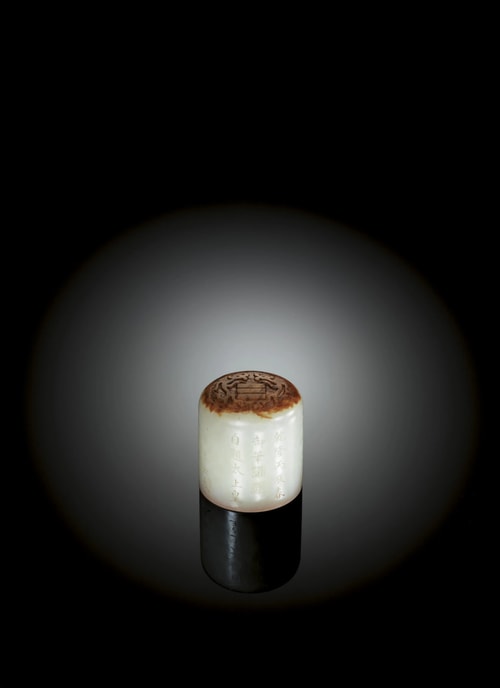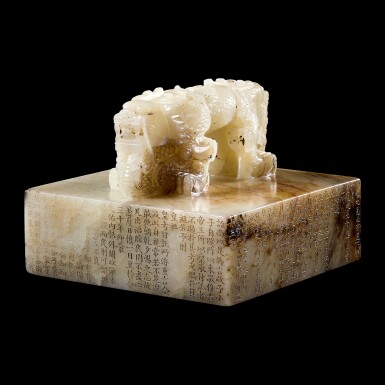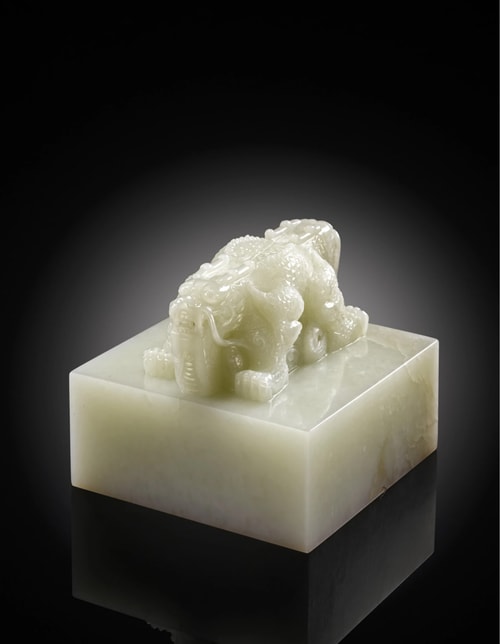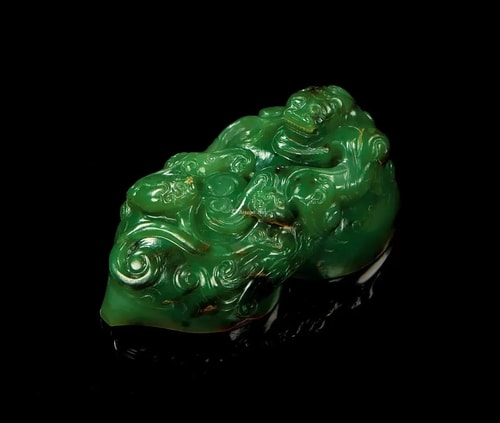“Treasure for Commanding and Rectifying All Nations” Seal with Jadeite Base from the Qianlong Emperor’s Twenty-Five Imperial Seals
Start time
2024-12-17
13:00
End time
2024-12-20
13:00
Distribute tokens
2024-12-21
10:00
Estimated time of trading
2024-12-23
06:00
Sale rules
Token Name: YUXI
Issuer: Japanese Collector Family
Total Supply: 10,000,000 (92% publicly issued)
Issuance Price: 0.1 USDT/YUXI
Underwriter: NCollector Platform
Issuance Fee: 8% (held by NCollector Platform)
Participation Requirement: Whitelisted users only
Token Holder Rights
Ownership Rights: The physical asset belongs collectively to all YUXI token holders. Each YUXI token represents a one-ten-millionth share of the asset's ownership.
Proposal Rights: Holders of more than 3% of MICHO tokens have the right to initiate proposals, such as voting on external exhibitions, auction consignments, and IP licensing.
Voting Rights: Token holders can stake their tokens to vote on various proposals, such as deciding whether to send physical collectibles to top auction houses like Sotheby’s or Christie’s for auction. If affirmative votes reach 51% of the total token supply, the platform will proceed with the auction process and deliver the collectibles to the auction house. The net proceeds from the auction will be distributed to all token holders in proportion to their holdings. After distribution, the corresponding tokens will be uniformly burned.
Revenue Rights: Token holders are entitled to profits generated from exhibitions, licensing, and derivative product issuance. These earnings will be distributed based on snapshots taken at specific time points.
Mandatory Buyout Rights: Once the secondary market is open, holders of 67% of YUXI tokens can initiate a mandatory buyout offer to the remaining 33% of holders at the average market price over the past seven days.
Physical Redemption Rights: A holder who acquires 100% of YUXI tokens can apply for the physical delivery and ownership confirmation of the asset. Upon completion, the corresponding tokens will be permanently burned.
About this artwork
Name: The 25th Imperial Xi of Qianlong – Treasure for Commanding and Rectifying All Nations with a Jadeite Base
Author: Emperor Qianlong
Provenance: Former Collection of a Japanese Family
Location: Japan MUFJ Bank Vault
Market Valuation: $20,000,000 – $30,000,000
Valuation Rationale
In the 2022 Sotheby’s Hong Kong Spring Auction, the Qianlong Yulan Zhi Bao Xi, crafted from Shoushan stone, sold for 153 million HKD, setting a new record for imperial Xi in Asian auctions. Similarly, in the 2011 Poly Auction Beijing Autumn Sale, the white jade Tai Shang Huang Di (Emperor Emeritus) Xi from the 60th year of Qianlong’s reign (1795) fetched 161 million RMB.
However, neither of these seals compares to the "Treasure for Commanding and Rectifying All Nations" in terms of material excellence or historical significance.
Material Superiority: The Qianlong Yulan Zhi Bao was carved from Shoushan stone, which is considerably less valuable than Hetian seed jade. Although the Tai Shang Huang Di seal was made of jade, it was much smaller in scale and of comparatively lower quality.
Historical and Political Importance: While over 1,800 Qianlong-era imperial Xi have survived, only 25 were designated for the emperor’s official use in exercising state power. This particular seal was among those few, specifically used in Qing diplomatic exchanges with foreign states—further underscoring its distinguished status and function in statecraft.
Additionally, Treasure for Commanding and Rectifying All Nations remains in pristine condition, complete with its added jadeite base. Given its unparalleled significance, it is reasonable to estimate its value at least double that of other Qianlong Xi.
Basic Information
Dimensions:
- Seal: 10.8 × 10.8 × 7.5 cm
- Base: 13.5 × 13.5 × 3.3 cm
- Material: Hetian Seed Jade, Hetian Jadeite Base
- Knob Design: Intertwined Dragon Knob
- Base Inscription
Left: Manchu script – Treasure for Commanding and Rectifying All Nations
Right: Chinese seal script – Treasure for Commanding and Rectifying All Nations
- Xi Impression
Left: Six Chinese seal script characters – Treasure for Commanding and Rectifying All Nations (raised relief)
Right: Six Manchu script characters – Treasure for Commanding and Rectifying All Nations (raised relief)
- Function
According to the Jiaotai Hall Treasure Register, Treasure for Commanding and Rectifying All Nations was designated for issuing imperial edicts to foreign nations. It was officially used for diplomatic correspondences, including replies to foreign envoys, vassal states, and minority political entities under Qing rule. The Xi symbolized the tribute system and the imperial authority over all nations.
Collection Description
This imperial Xi of Emperor Qianlong is crafted from Hetian white jade, exhibiting a warm and delicate texture. The milky white jade carries a subtle bluish hue with natural veining. The Xi is large and square-shaped, precisely proportioned. On its base, the left side features six deeply carved Chinese seal script characters: Treasure for Commanding and Rectifying All Nations, while the right side bears the same inscription in Manchu script, both in raised relief. The calligraphy is bold and powerful, with masterful carving and a meticulously balanced composition. The Xi is accompanied by a jadeite base.
The top of the Xi is adorned with an exquisitely carved pair of intertwined chi long (mythical hornless dragons), facing opposite directions. Each long has wide-open eyes, flared nostrils, curling whiskers, and exposed sharp teeth, exuding an imposing yet dynamic presence. Their scales and flowing manes are intricately sculpted, with fluid, lifelike lines. The long’s bodies are tightly intertwined, their limbs crouched, appearing vivid and full of energy. On either side of the long, two inscriptions are carved: The Treasure of Qianlong’s Calligraphy and The Treasure of Qianlong’s Imperial Viewing. A central perforation allows for the Xi to be suspended with a cord.
The sides of the Xi are engraved with an inscription in regular script, which reads:
"In ancient times, Jing Jiang once said: “When people are diligent in labor, they become reflective; through reflection, virtue emerges. However, if they indulge in comfort, decadence ensues, leading to the erosion of virtue and the rise of vice. This aligns with the teachings of Confucius, who emphasized labor as a means of cultivation. Education and governance are fundamentally one—where there is teaching, there must be discipline. Thus, the duty of officials is not merely to instruct, but also to guide the people through diligence.
“By establishing rites and moral education, the state fosters virtue. However, ordinary folk often perceive such governance as restrictive and difficult to implement. Hence, the practice of agriculture and sericulture is encouraged, where farmers, under the scorching sun and pouring rain, oversee their children, urging them to work hard. Though the young may resent labor at first, they eventually recognize the wisdom behind it. If even a father disciplines his child with love, should not a ruler govern his people with care?”
“True governance does not burden the people needlessly. A wise ruler leads by example, governing with sincerity and benevolence. In doing so, though the people may toil, they will not see it as hardship—just as children follow their fathers with trust and respect."
The inscription is gilded, with precisely aligned, well-proportioned characters. The carving is fluid and refined, reflecting Emperor Qianlong’s literary prowess and his deep appreciation for cultural refinement.
Creation Background
Emperor Qianlong drew inspiration from ancient rulers to determine the number of imperial Xi, symbolizing the enduring prosperity of his dynasty. Over his lifetime, he commissioned the creation of more than 1,800 imperial Xi from various materials, including bronze, jade, stone, crystal, agate, ivory, bamboo, amber, and clay. The inscriptions on these Xi varied widely, encompassing Confucian classics, poetry, and Qianlong’s own writings.
This particular Xi was one of the twenty-five specially designated imperial Xi and played a crucial role in Qing diplomatic ceremonies. It served as an indispensable symbol of Qing authority in international relations, representing the supreme power of the state.
Before Qianlong’s reign, there was no fixed number of official imperial Xi. By the early Qianlong period, records indicate at least twenty-nine types and thirty-nine Xi designated for national use. However, inconsistencies in historical records and unclear functions led to confusion. To address this, in 1746 (Qianlong’s 11th year of reign), Emperor Qianlong systematically examined and reorganized the imperial Xi of previous dynasties, ultimately establishing a definitive set of twenty-five Xi, including:
- *Treasure of the Great Qing’s Mandate*, *Treasure of the Emperor’s Divine Authority*, *Treasure of the Great Qing’s Heir to Heaven*, *Two Emperor’s Treasures*, *Treasure of the Son of Heaven*, *Treasure of the Emperor’s Reverence to His Kin*, *Treasure of the Emperor’s Affection for His Kin*, *Treasure of the Emperor’s Deeds*, *Treasure of the Emperor’s Trust*, *Treasure of the Son of Heaven’s Deeds*, *Treasure of the Son of Heaven’s Trust*, *Treasure of Reverence to Heaven and Diligence to the People*, *Treasure of Imperial Decrees*, *Treasure of Imperial Edicts*, *Treasure of Lasting Teachings*, *Treasure of Virtuous Decrees*, *Treasure of Revered Writings*, *Treasure of Classical Literature and History*, *Treasure of the Emperor’s Inspections*, *Treasure of Justice and Peace*, *Treasure of Military Command*, *Treasure for Commanding and Rectifying All Nations*, *Treasure of Commanding All People*, and *Treasure of Expanding Fortune*.
At the same time, Qianlong compiled the *Imperial Xi Register* (now housed in the First Historical Archives of China), specifying the functions of these twenty-five Xi, which collectively represented all aspects of the emperor’s supreme authority. According to He Shengsheng’s Yan Zui Za Ji (Miscellaneous Records of a Drunken Recluse), the Hall of Union (Jiaotai Hall) housed these twenty-five Xi as early as Qianlong’s 11th year, each with distinct inscriptions and functions.
In 1746, except for the green jade Xi, which bore only Manchu script, the other twenty-one imperial Xi featured both Manchu and Chinese seal script. However, in 1748 (Qianlong’s 13th year), Emperor Qianlong sought greater uniformity between Manchu and Chinese inscriptions and ordered that, with four exceptions (*Treasure of the Great Qing’s Mandate*, *Treasure of the Divine Mandate*, *Treasure of the Great Qing’s Succession*, and *Green Jade Xi*), all other twenty-one Xi be re-engraved in Manchu seal script. These are the twenty-five imperial Xi that survive today.
Author Biography
Emperor Qianlong (Aisin Gioro Hongli, 1711–1799) was the sixth emperor of the Qing Dynasty. He was also known by the literary pseudonyms "Changchun Jushi" (Hermit of Eternal Spring) and "Xintian Zhuren" (Master Who Trusts in Heaven). In his later years, he referred to himself as "Guxi Tianzi" (Elderly Son of Heaven) and "Shiquan Laoren" (Perfected Elder). His reign title, "Qianlong", signified "Heavenly Prosperity".
He reigned for sixty years, and after his formal abdication, continued to oversee state affairs for another three years—exercising de facto imperial authority for a remarkable 63 years and four months, the longest













